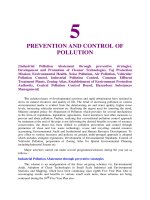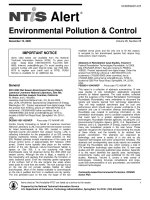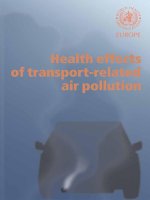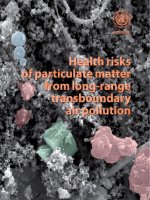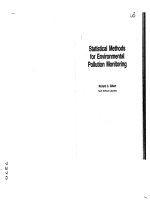Environmental pollution ppt
Bạn đang xem bản rút gọn của tài liệu. Xem và tải ngay bản đầy đủ của tài liệu tại đây (46.49 KB, 12 trang )
Environmental pollution
Definition
Environmental pollution is the build-up and concentration of toxic levels of chemicals
in the air, water, and land, which reduces the ability of the affected area to support
life. Pollutants may be gaseous- ozone and carbon monoxide, for example; liquid-
discharge from industrial plants and sewage systems; or solid-landfills and junkyards.
Description
Where water exists, life is possible. Where no water exists, no life is possible it
cleans, transport, irrigates, cools, fuels, and stabilizes the functioning of everything
from a single cell to the entire planet. It is what distinguishes Earth from the rest of
the known universe.
Water is the most precious commodity- but paradoxically abundant enough for its true
value to be overlooked or under appreciated (about 80% of the Earth surface is
covered by water) in those areas of the earth where water is scarce, issues surrounding
Its use is a matter of life and death oftenly leading to conflicts between the riparian
and any interested party. Eg.the pastoral communities and in the Middle East over the
use of the River Jordan waters.
Lake Naivasha is in Naivasha municipality Naivasha Division, Nakuru District in Rift
Valley Province in Kenya. The spatial extent of the municipality is approximately
941km
2
, which includes the 241km
2
covered by the lake, making it one of the largest
municipalities in the country. Naivasha is located 90km north-west of Nairobi and
70km from Nakuru town. The Trans-African Highway serves it from Mombasa-
Nairobi-Kisumu to the Uganda road and the Old main road from Nairobi through the
Longonot-Kijabe route. This has ensured a heavy traffic of buses and heavy trucks
passing through the town. The main railway line from Nairobi to Kisumu, Kitale and
Eldoret passes through Naivasha Station. The Council lies between latitude 0
0
09` and
0
0
55` South and between longitudes 35
0
50` and 36
0
42` East.
Lake Naivasha drainage basin
River Malewa and River Turasha are the only rivers in the drainage basin. The
Malewa River drains off Sattima, its headwaters reaching up to the highest upland
valleys. It plunges down the Sattima Escarpment onto the Ol Bolossat plain through a
magnificent steep walled gorge, with walls nearly 1,000 feet high, the Malewa ndogo
gorge. The river cuts a deep trench across the Ol Bolossat plain passing very close to
the south end of the lake and separated from it by a divide of very low relief probably
not more than 30 feet. The river turns south and cuts another deep gorge, the lower
Malewa gorge, along a fault line, to its confluence with the Turasha River just south
of the Malewa Water Scheme Intake. The Turasha River like the Malewa is a
permanent stream. It drains the north Kinangop plateau and the mountain range to the
east of it. It follows a u-shaped course, flowing northwards towards Kinangop plateau
collecting tributaries from the forested massif of Kipipiri, before curving right round
to join the southward flowing Malewa. Like the Malewa it has excavated a deep-
walled cut several hundred feet deep in the flat-topped tuff plateau, and its tributaries
are similarly incised. The deep steep-walled incisions of these river valleys appear to
be due to the sudden lowering of base level in the floor of the rift valley consequent
on the major fault movement of the Pliocene period. The Malewa ndogo gorge is
related to movement on the Sattima fault at the same time. The two streams after
being united flow southwards to feed Lake Naivasha.
Environmental changes over the last ten years
The ecosystem of the lake is under threat due to the rise in human population density
leading to intensive irrigation, farming, land subdivision, and intensive use of agro-
chemicals and deforestation around the lake. The growth of the township has also led
to more runoff, siltation and nutrients being discharged into the lake via inflowing
rivers and drainage channels along roads and the other infrastructure. Inadequately
treated effluents from the ton's sewage treatment plan are also finding their way into
the lake.
The intensive agriculture to the south of the Township is itself a grave environmental
threat. This is because intensive agricultural practices are concentrated on the riparian
of the lake whereby we have large horticultural, floricultural and vegetable farms
drawing enormous quantities of water from the lake for irrigation. The study area is
located on an ecosystem that is of low carrying capacity and as such this has
necessitated excessive use of agro-chemicals to enhance productivity. The effects
from these practices is that the chemicals find their way into the lake through runoff
from the agricultural parcels of land. Because the land generally slopes towards the
lake. Poor tillage practices often result in soil erosion and the loose soil is carried
awash into the lake. All these result in increased eutrophication of the lake’s waters.
The lake has no river outlet except for underground outlets in the southern part of the
municipality. This is around Longonot and Olkaria Power Generation), and the
importance of this is that storm water and urban or agricultural run off finding its way
into the lake should not have any deleterious effects. Poor waste disposal practices,
given the topography of the area would result in enhanced cultural eutrophication of
the lake, a threat to aquatic life and water contamination. Urban runoff from roads,
laden with soil particles, garbage and petroleum products from petrol filling stations
within the municipality, ends up in the lake. This further increases eutrophication and
water pollution.
List of proposed actions or solutions
The author has put forward the following recommendations:
• Terracing the sloppy areas: This will reduce the speed of run off by giving it
time to infiltrate into the soil.this will reduce the rate of soil erosion which
inturn will reduce the rate of siltation of the lake.
• Afforestation and conservation of vegetation cover: trees are very important in
reducing the impact of raindrop on the soil through interception storage. The
roots help in holding the soil particles together. When trees die or shed their
leaves they increase the humus content of the soil hence improving the soil
structure.
• Digging dry wells: dry wells are pits dug on the ground to harvest run off.they
increase the rate of infiltration of the run off into the soil.
• Rain water harvesting: this should be done by use of gutters to collect water
from buildings and then stored in tanks.this will provide fresh clean water for
domestic use and if well managed will reduce over dependency on boreholes
and surface water sources which must be treated before consumption.
• Town planning: the municipal council should come up with sound
development plan for the area around the lake to get rid off of the unplanned
mushrooming slums where the fishermen reside.
• Naivasha Municipal Council (NMC) needs to improve its revenue collection so
as to boost the capacity to manage environmental degradation problems
occurring within the area. In order to tap all the available revenue sources and
counter financial management problems, the council needs to ensure adequate
supervision and accountability in the revenue collection exercise; modernise its
water and sewerage billing so as make it more efficient and eliminate illegal
connections; and lastly reduce the amount of debts owed to the council by
individuals, organisations and the government departments and agencies
present in the municipality. Other suggestions would be to make improvements
in staffing and on accounting. This could be through staff training and
computerisation of operations especially putting up a management information
system for the budget, and register of all clients, creditors/debtors and a license
register when funds become available.
• There is need to diversify urban-development activities within the
municipality. An outward spread of these development activities and the creation
of satellite towns in areas such as Olkaria, Sulmac and Sharlimar would minimise
the pressure on the natural environment, land, forests, air and water resources, as
well as on the capacities of socio-economic infrastructures such as sewerage and
water supply facilities and roads. This will also result in a reduction of land use
conflicts, which is a major cause of environmental degradation in any given urban
scenario.
• Proper planning and provision of infrastructure is the responsibility of the local
authority, non-governmental organisations and the community in the area and this
ought to be improved upon. The general public should also utilise and maintain
the services offered more efficiently.
The Physical Planning Act
provides for the preparation, approval and
implementation of physical development plans irrespective of whether they are on
government, trust and/or private land. Participatory planning approach should be
applied in planning and development processes for a more sustainable urban-
development in the lake Naivasha basin. Otherwise, physical planning risks being
rendered irrelevant to the landowners, the community and other stakeholders in
land development.
This is very important bearing in mind that with the current scarcity of land almost
all towns now can only expand into private land or land earmarked for other
activities like wildlife conservation and agriculture.
• Monitoring settlement growth around the lake should be carried out regularly. In
the study, “Impact of Urban Land use in Naivasha”, M.Mbathi (1998), it was
surprising that some settlements in the area grew without proper documentation
and planning. The example given was the Karagita settlement, which covered an
area of approximately 200 hectares and had a resident population of more than
15,000 people but did not have a layout plan. Many other settlements continue to
grow under the same circumstances. The situation could go out of hand if left
unchecked. The local authority and other key-players in the development of
Naivasha, especially the riparian owners association and the flower growers,
should always consider the proper planning and maintenance of the settlements as
a priority.
• Provision of basic services in Naivasha town itself and other considerably large
urbanised area in the municipality will help reduce the amount of wastes released
into the environment. A point in hand is the case of the town’s sewerage treatment
plant. From the Project Information Sheet, Naivasha Municipality’s 2000-2004
Local Authority Development Plan (LAPD), pg. 92, the new treatment plant has
been rendered inoperational due to vandalism of the electrical components in
1994. This has meant that the facility is currently being used as a lagoon and that
untreated municipal effluents are being discharged directly into the lake thereby
raising serious concerns over contamination of Lake Naivasha.
The lake is an important and reliable source of fresh water. The disposal of
untreated sewage into the lake has serious ecological implications particularly
relating to cultural eutrophication (nutrient enrichment), increase in biochemical
oxygen demand (BOD) and toxicity of available chemicals to biota. It also raises
public health concerns relating to the spread of water-borne diseases such as
cholera, dysentery and typhoid.
The sewage system should be rehabilitated and guarded to avoid incidences of
vandalism in future. A greater concern and that ought to be addressed urgently is
the location of the sewage treatment plant a mere 500 meters only from the lake.
This is in spite of the town’s topography that slopes towards the lake. Measures
should be put in place to ensure that the system is not used beyond its capacity and
also insuring against urban runoff overflowing and carrying awash raw sewage
from the plant into the lake. The local authority and government agencies
responsible are proposed to take up this responsibility. The large and financially
capable horticulture and floriculture firms should put up their own sewage
treatment plant so as to increase the overall capacity of the municipality to treat
and dispose of wastes properly.
• The role of the community is an important one indeed. These are the people who
suffer most in the event of the environment being degraded beyond its carrying
capacity. It is important therefore to involve them in various decision-making
processes and also educate the general public on the impacts of environmental
degradation and how their actions can contribute to or help reduce this.
• The development of an urban information system as well as the use of GIS in
Environmental Planning and Management, right from decision-making support to
policy formulation, implementation and monitoring, is necessary in Naivasha
town just as it is in other urban areas in the country. This would provide a good
base for monitoring specific trends that may be associated with environmental
degradation. The lack of readily available data hampered this research and this led
to much time and resources being spent on data collection. This is an indication
that the town planners could also be lacking updated information for most of their
decisions. Making appropriate decisions in future depends entirely on the data that
is collected now and placed in a system in which it is easily accessible for
manipulation and regular up-dates. However, it is understandable to the author
that this may be a difficult proposition given the financial and other technical
implications. This thus calls for the need by the municipal council to approach
donors and other charitable organisations for assistance.
• The Environmental Management and Co-ordination Act (1999) should be applied
and enforced by the concerned parties. This will discourage polluters and others
who may practice activities that are likely to lead to environmental degradation.
Other legislature like the Water Act and the Public Health Act must be enforced to
ensure compliance and a more efficient use of water and the riparian of Lake
Naivasha. Means could be devised to ensure that the flower farmers, who
currently draw the largest proportion of water from the lake at no cost, aid the
council in service provision. The local authority should develop ordinances aimed
at restricting or prohibiting developers within Naivasha Municipality from putting
up buildings if proper sanitation and waste disposal is not provided.
Bibliography
Gleick, Peter H. 2001. The world's water 2000-2001.Washington, D.C.:Island Press.
World health Organization.2000 .Global Water Supply and Sanitation
Assessment.Geneva: WHO.
Web sites
www.world
water.org
General information on the Word's water resources.
www.wri.org
World Resource Institute. Earth Trends: The environmental information portal
PERMISSION FORM-MY COMMUNITY, OUR EARTH PROJECT
MyCOE Agreement (For Project No.1353)
1. In consideration of the mutual promises and for other good and valuable
consideration, the receipt of which are hereby acknowledged, I ANTHONY
GATHAMBO
(Owner) hereby grant the principals and sponsors of the My
Community, Our Earth (MyCOE)Project nonexclusive, irrevocable,
worldwide license right and royalty-free permission to use, copy, reproduce,
(re)publish, (re)distribute, and publicly display and perform the map
image(s) identified below in various venues, formats , and mediums of
communication:
[yes]My community Our Earth map image(s) in hard copy,
electronic, or other formats/mediums now known or later
developed, and for all other business, marketing, and education
purposes of the principals and sponsors of the MyCOE Project
without further permission of the owner, so long as the owner's
copyright attribution is affixed to the map images)
Owner warrants that it owns and/or has rights to grant permission to the map
image(s) submitted herein and that the map image(s) does not infringe any
proprietary rights of third persons, does not contain any information that is
unlawful or libelius, and does not violate any person's right to privacy and/or
publicity. Owner agrees to defend, indemnify, and hold principals and sponsors,
and their respective directors, officers, employees, agents, and subcontractors of
the MyCOE Project harmless from and against any and all liability, expense,
costs, or damage arising from owner's failure to meet the aforementioned
obligations.
Due to the nature of internet and other electronic means of transmission, owner
expressly understands and agrees that the web version of the map image(s) may
be viewed, displayed, reproduced, printed, retransmitted, and/or rebroadcast by
the general public.
Map Number and Title(s): 1 LAKE NAIVASHA TOWNSHIP
Copyright Attribution: Kihiu 2002
Contact Name: ANTHONY GATHAMBO
Signature: AKG Date:29
th
May 2002
Organization Name : MOI UNIVERSITY
Address: 3900 Eldoret Kenya
Telephone: 0733 234238



